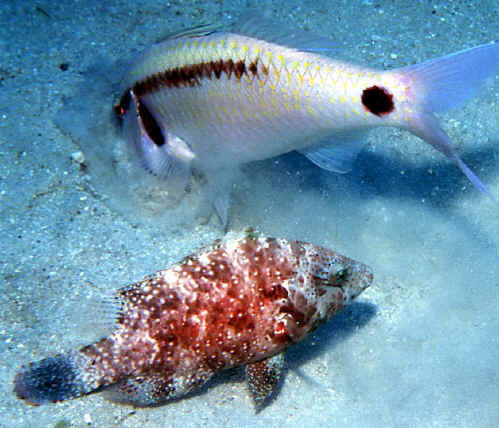Goatfish Foraging Relationships
This article is written by Andy Lewis of
Tevene'i Marine based in
Australia. Tevene'i Marine is a Coral Reef Ecology Consultancy and Ecotourism
business established by Dr. Andrew Lewis and Daniela Lewis, graduates
of the Department of Marine Biology at James Cook University.

This image is part of a stereo
pair, shot on Lizard Island, Australia. It shows Parupeneus barberinus
engaged in feeding, being watched by a species of Labrid, Cheilinus
chlorurus. All goatfish (Family Mullidae) have barbels, and they use
them to sense and smell out small invertebrates from under the sediment.
This is what the Parupeneus barberinus in the above shot is doing
with its head buried down in the sand.
Biological Background
The images of the month illustrates an example of what marine biologists
call a "multi-species foraging association". As the name
suggests, these associations consist of individuals from more than one
species, which come together and simultaneously engage in feeding behaviour.
These associations can be seen frequently on coral reefs, and there is
considerable variation in the size and composition of the feeding schools.
The smallest associations just consist of a pair of fishes, and usually
both species are benthic carnivores, such as the goatfish and the wrasses
illustrated in this months images. Often, one member of the pair is the
"leader" and seems to decide the direction and precise feeding
locations, while the other member is the "follower" and just
feeds wherever the leader does. In some cases both the leader and follower
have similar diets, whereas in other associations, the follower has a
different diet and often feeds opportunistically on prey disturbed by
the leader. An example of the latter we have studied at Orpheus Island
is the moon wrasse (Thalassoma lunare) following large parrotfish
(Chlorurus microrhinos) and picking at boring invertebrates exposed
when the parrotfish disturbs the reef surface as it bites algae with its
powerful jaws. We found that the moon wrasses feed up to three times faster
when they are in association with the parrotfish, compared to when they
are feeding alone.
Other associations consist of groups of fishes from
many different species. In some associations, the fishes may all share
a similar diet (i.e. carnivores like Chaetodontids, Mullids, Labrids all
feeding together), or consist of fishes from widely different trophic
groups (i.e. carnivores and herbivores). Some of the biggest associations
form when carnivores join large roving schools of herbivorous fishes -
a typical school may consist of 50 parrotfish (Scaridae), 10 rabbitfish
(Siganidae), 10 surgeonfish (Acanthuridae), and 2-5 individuals of goatfish,
butterflyfish, wrasses, and angelfish. The whole school swims along in
unison, and then at some particular place (often decided by the herbivores),
the school descends to the bottom and begins to feed within a relatively
small area. The interesting aspect of this behaviour is that once feeding
commences, each different species adopts its particular feeding mode,
with the herbivores nipping algae, the goatfish sifting sediment with
their barbels, the butterflyfish eating live corals, etc. After a short
time (30 seconds to 1 minute), the school ascends en masse and moves again
to another location.
The composition of these multi-species foraging associations
is quite flexible, with fishes entering and leaving the schools over time.
At some locations, there seems to be a daily pattern - for example at
Watson's Bay at Lizard Island, the rabbitfishes usually forage in pairs
in the morning, but in the afternoon, form large schools of several hundred
individuals (mainly Siganus doliatus, S. puellus, &
S. corallinus), which also include butterflyfishes, wrasses, and
goatfish.
There are several possible reasons why fishes may form
these foraging groups instead of feeding alone. First, they may get access
to more food, particularly in cases like the moon wrasse and the parrotfish,
where the parrotfish disturbs food items that can be consumed by the smaller
wrasse. Second, there is the obvious minimisation of individual predation
risk that comes through schooling behaviour.
Finally, fishes may use
these larger schools to reduce aggressive encounters with the territorial
damselfishes which defend algal turfs over much of the reef surface. The
latter can be very aggressive to single fishes (herbivores and non-herbivores)
that enter their territory, but when 40 or 50 fishes enter at once to
feed, the damselfish is overwhelmed and often "gives up the fight"!


